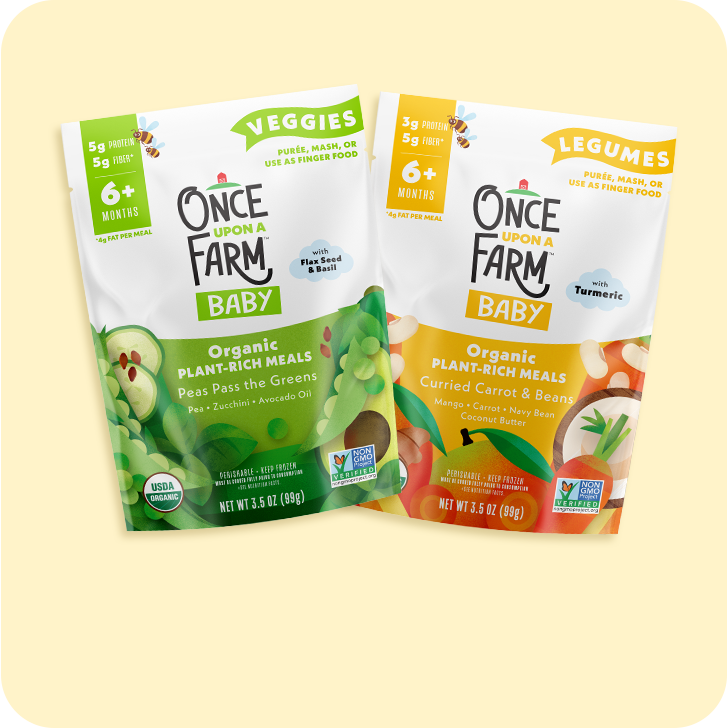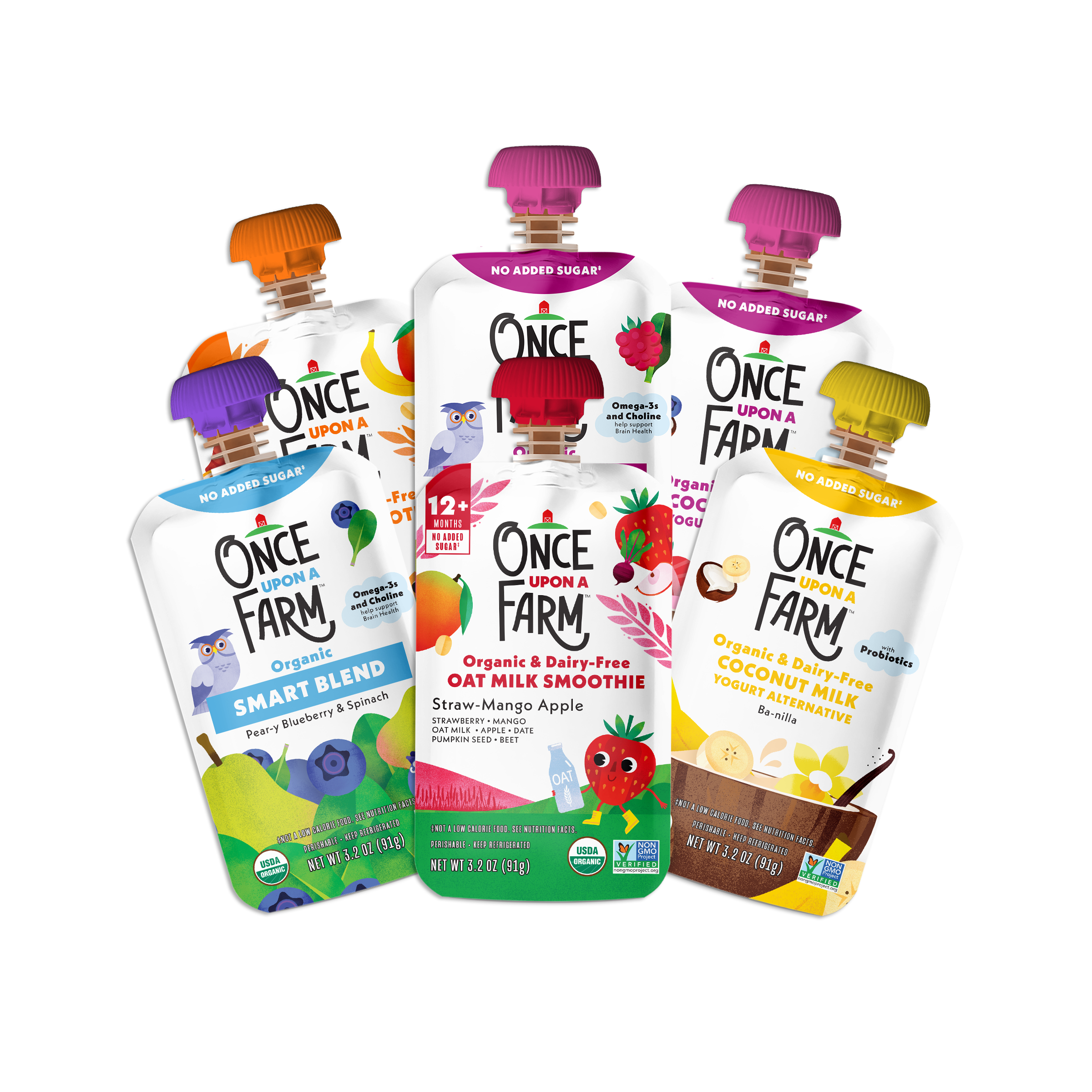Note: This blog is not medical advice and is for informational purposes only. For any specific nutrition recommendations, please refer to your child’s healthcare provider.
So, your little one is coming up on six months? How exciting! Experts recommend starting solids around six months, which means you’re probably deep in the research and preparation phase. We’re here to help.
1. Prepare For a Mess
It’s likely your baby is going to dive right into solids—hands and face first! Things will get messy. A splat mat under their high chair can be extremely helpful in mitigating the mess, or at least making it easier to clean up! If your little one is OK with it, a pocketed bib can help catch food that (inevitably) gets dropped, and suction bowls can help keep food from flying.
2. Try, Try Again
As your baby is trying all the new things, there will be things they like, and most certainly things they don’t. However, that doesn’t mean they won’t. “Babies need to be exposed to a food several times before accepting it,” explains O’Farm Expert, Nicole Lattanzio, RD, CSP, IBCLC.
If your baby has rejected a food, it can be offered again anytime. Lattanzio encourages offering a food three times a week, then retrying again in a week or two when it makes sense for them. “If it’s something that is in a meal you’re making anyways,” she says, “offer just a tiny portion for exposure.”
3. Heavy on the Finger Foods
When starting with self-feeding, offering finger-length strips of food that are soft and easily squishable can be a great way to help your baby develop their pincer grasp. Lattanzio suggests avocado slices, banana wedges, and steamed/roasted sweet potato strips. As families move on to offering meals with multiple ingredients, after your baby has shown they can tolerate several foods, you can add spreads onto the strips. Also, she adds, “You can also easily boost nutrition by rolling fruit or veggie strips in ground flax and hemp seeds!”
4. What About Utensils?
In terms of encouraging the use of utensils, a spoon can be used—or offered—from the beginning. “Preloading spoons allows them to grab the utensil and bring [it to their] mouth to feed themselves,” Lattanzio tells us. “As they get older, around 10 months or so, babies are more efficient with a spoon and can scoop using the spoon from a bowl.”
Forks can be a bit trickier as it’s hard for them to poke the food successfully, which can cause frustration. Similar to spoons, Lattanzio says, “you can offer baby forks preloaded for self-feeding; however, most littles begin to poke food with a fork around age 15 months or so.” As with all things, your kiddo will get better with time. If they prefer just using their hands, that’s totally fine!
5. Introducing Allergens
Top allergens (e.g., dairy, egg, peanut, tree nuts, sesame, soy, fish, shellfish, and wheat) can begin to be introduced when your little one starts solids and is tolerating a few foods. Start with one allergen at a time. Let’s say you start with peanuts. “Plan to offer it earlier in the day and when your baby is feeling well,” explains Lattanzio. “You can spread a thin layer of creamy peanut butter on a strip of banana as part of their meal. Offer the same allergen for at least a few days in a row to make sure they get good exposure to it and then plan to offer at least weekly.” Offering weekly is especially important for peanut and egg allergens, she notes. If there is a family history of food allergies, your child has eczema, other allergies or reactions, you should consult with your child’s doctor before starting to introduce allergens.
6. Offering Water
Water can be offered at meals once your little one is 6+ months old. Lattanzio suggests offering 1–2 ounces in an open cup to help them practice drinking. “Keep in mind that in those first few months of starting solids, water is for fun!” she says. And yes, it’s okay if they don’t drink much.
7. On Serving Sizes
Worrying about offering too much or not enough food? Don’t fret! “I’m a big advocate of not worrying about serving sizes or portion sizes,” says Lattanzio. “Every baby is different, and their appetite will vary meal to meal, day to day, and month to month!” Instead, focus on offering an appropriate number of meals each day for their age. As a guideline, consider offering:
- 6–7 months: About 1 meal
- 8–9 months: 2 meals
- 10–12 months: 3 meals (Some babies 10+ months may need a snack as well)
She suggests offering around 3 food items (or at minimum, food groups) at each meal. “As your baby eats, refill their plate with more if they are asking or seem to be looking for more.” The right serving is the amount your little one eats. Remember that in the early months, most of your child’s nutrition is coming from breastmilk or formula.
8. Pouches, Please
Lucky for you (and baby), pouches can be introduced right when starting solids. They are convenient and a great on-the-go option. “If offering a pouch while at home, consider squeezing the blend onto preloaded spoons for self-feeding and skill development,” says Lattanzio. She recommends families offer a mix of pouches and other solid foods to allow for exposure to new textures and to help support oral motor development.
9. Mind Your Pets
If you have a furry friend at home, be extra mindful of that mess. As a pet owner, you know there are foods your dog or cat cannot eat and you’re sure to keep those out of reach of curious paws. However, your baby doesn’t have that same intel and they’re not thinking to keep those chopped-up grapes or food flavored with garlic and onions off the floor. So, just keep an eye on what gets dropped when your pet is nearby.
As with all things parenting, you’re going to approach solids in the way that works for your family. And that’s the way that will work best!


















